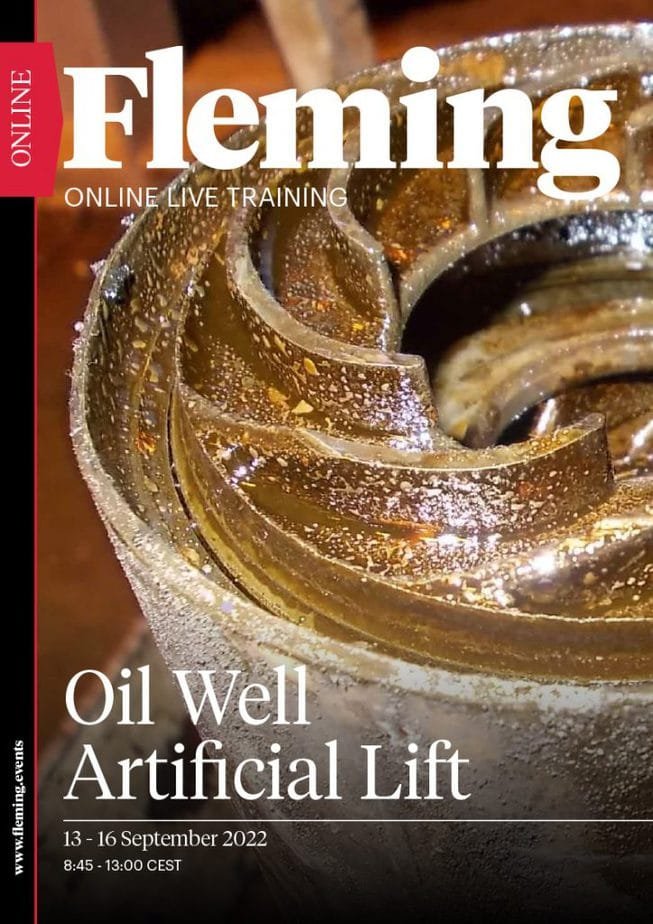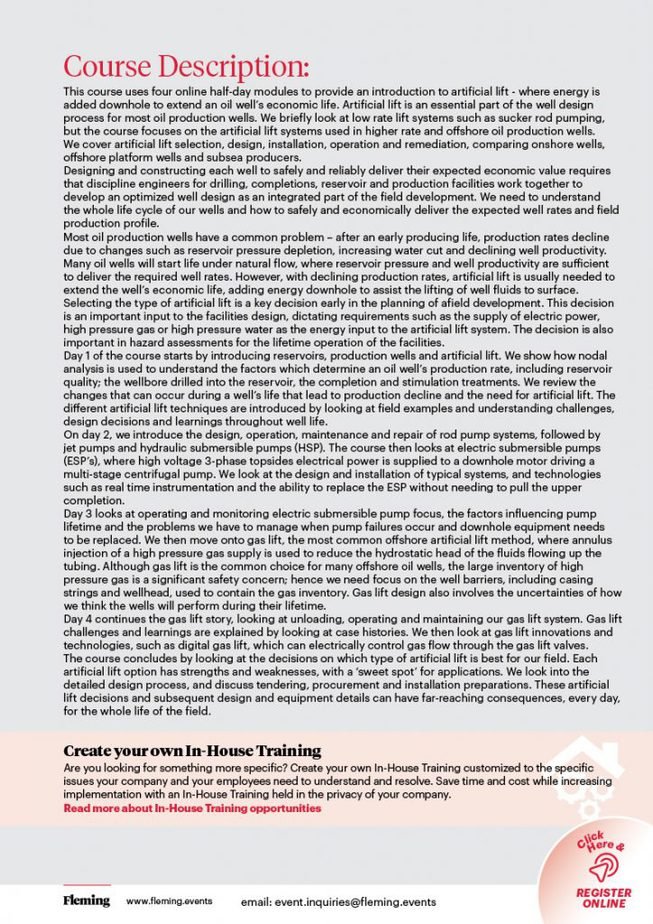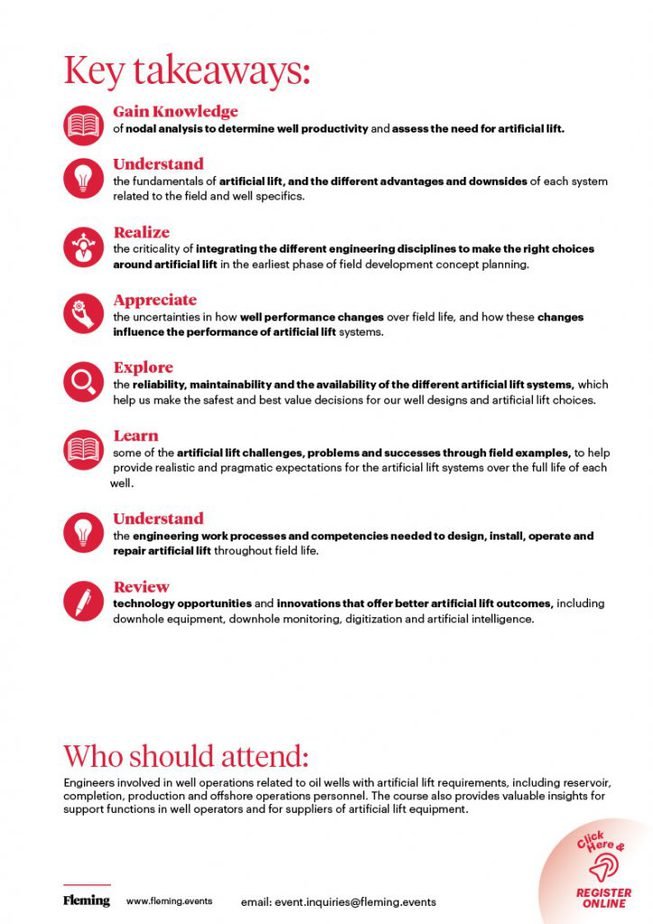meet the training leader
This course is not currently scheduled but may be offered at your company site.
Please contact Fleming for more information.
All sessions of this unique course online
Live interaction options between the delegates and trainer
Available via mobile, tablet or laptop
This course uses four online half-day modules to provide an introduction to artificial lift – where energy is added downhole to extend an oil well’s economic life. Artificial lift is an essential part of the well design process for most oil production wells. We briefly look at low rate lift systems such as sucker rod pumping, but the course focuses on the artificial lift systems used in higher rate and offshore oil production wells. We cover artificial lift selection, design, installation, operation and remediation, comparing onshore wells, offshore platform wells and subsea producers. Designing and constructing each well to safely and reliably deliver their expected economic value requires that discipline engineers for drilling, completions, reservoir and production facilities work together to develop an optimized well design as an integrated part of the field development. We need to understand the whole life cycle of our wells and how to safely and economically deliver the expected well rates and field production profile.
Most oil production wells have a common problem – after an early producing life, production rates decline due to changes such as reservoir pressure depletion, increasing water cut and declining well productivity. Many oil wells will start life under natural flow, where reservoir pressure and well productivity are sufficient to deliver the required well rates. However, with declining production rates, artificial lift is usually needed to extend the well’s economic life, adding energy downhole to assist the lifting of well fluids to surface. Selecting the type of artificial lift is a key decision early in the planning of afield development. This decision is an important input to the facilities design, dictating requirements such as the supply of electric power, high pressure gas or high pressure water as the energy input to the artificial lift system. The decision is also important in hazard assessments for the lifetime operation of the facilities.
Day 1 of the course starts by introducing reservoirs, production wells and artificial lift. We show how nodal analysis is used to understand the factors which determine an oil well’s production rate, including reservoir quality; the wellbore drilled into the reservoir, the completion and stimulation treatments. We review the changes that can occur during a well’s life that lead to production decline and the need for artificial lift. The different artificial lift techniques are introduced by looking at field examples and understanding challenges, design decisions and learnings throughout well life.
On day 2, we introduce the design, operation, maintenance and repair of rod pump systems, followed by jet pumps and hydraulic submersible pumps (HSP). The course then looks at electric submersible pumps (ESP’s), where high voltage 3-phase topsides electrical power is supplied to a downhole motor driving a
multi-stage centrifugal pump. We look at the design and installation of typical systems, and technologies such as real time instrumentation and the ability to replace the ESP without needing to pull the upper completion.
Day 3 looks at operating and monitoring electric submersible pump focus, the factors influencing pump lifetime and the problems we have to manage when pump failures occur and downhole equipment needs to be replaced. We then move onto gas lift, the most common offshore artificial lift method, where annulus injection of a high pressure gas supply is used to reduce the hydrostatic head of the fluids flowing up the tubing. Although gas lift is the common choice for many offshore oil wells, the large inventory of high pressure gas is a significant safety concern; hence we need focus on the well barriers, including casing strings and wellhead, used to contain the gas inventory. Gas lift design also involves the uncertainties of how we think the wells will perform during their lifetime.
Day 4 continues the gas lift story, looking at unloading, operating and maintaining our gas lift system. Gas lift challenges and learnings are explained by looking at case histories. We then look at gas lift innovations and technologies, such as digital gas lift, which can electrically control gas flow through the gas lift valves. The course concludes by looking at the decisions on which type of artificial lift is best for our field. Each artificial lift option has strengths and weaknesses, with a ‘sweet spot’ for applications. We look into the detailed design process, and discuss tendering, procurement and installation preparations. These artificial lift decisions and subsequent design and equipment details can have far-reaching consequences, every day, for the whole life of the field.
Reveal the full schedule of the training as well as key topics, course objectives, key takeaways, special features, and the trainer bio!



This course is not currently scheduled but may be offered at your company site.
Please contact Fleming for more information.

| Cookie | Duration | Description |
|---|---|---|
| cookielawinfo-checkbox-analytics | 11 months | This cookie is set by GDPR Cookie Consent plugin. The cookie is used to store the user consent for the cookies in the category "Analytics". |
| cookielawinfo-checkbox-functional | 11 months | The cookie is set by GDPR cookie consent to record the user consent for the cookies in the category "Functional". |
| cookielawinfo-checkbox-necessary | 11 months | This cookie is set by GDPR Cookie Consent plugin. The cookies is used to store the user consent for the cookies in the category "Necessary". |
| cookielawinfo-checkbox-others | 11 months | This cookie is set by GDPR Cookie Consent plugin. The cookie is used to store the user consent for the cookies in the category "Other. |
| cookielawinfo-checkbox-performance | 11 months | This cookie is set by GDPR Cookie Consent plugin. The cookie is used to store the user consent for the cookies in the category "Performance". |
| viewed_cookie_policy | 11 months | The cookie is set by the GDPR Cookie Consent plugin and is used to store whether or not user has consented to the use of cookies. It does not store any personal data. |